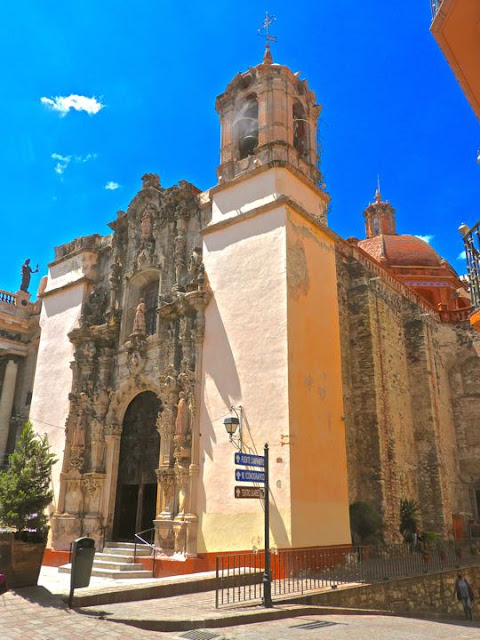In this posting, will provide some background on this fight and the impact on the early stages of the War of Independence. We will also visit another nearby attraction, the Mercado Hidalgo, a huge structure filled with hundreds of booths selling ceramics, clothing, toys, leather goods, raw and cooked food and much else. Finally, we'll take a walk through Jardin Reforma, a quiet and lovely park across from the Mercado that is perfect for relaxation on a warm day.
The Alhondiga's thick stone walls, small windows, and limited access were intended to protect grain stored by the city council and to ensure Guanajuato's inhabitants could buy wheat and corn at controlled prices. Its construction was ordered in 1796 by Spanish Viceroy Miguel de la Grúa Talamanca de Carini yBranciforte. and it was designed by the architect José de Mazo Avilés.
The Alhondiga was completed November 9, 1809, less than a year before Hidalgo launched his revolt. As the insurgent forces approached, the Spanish believed that the grain would help them withstand a siege and that the building itself would protect them because Hidalgo had little or no artillery at this point. Neither belief would prove true.
Guanajuato was then, and still is, one of the most important silver mining centers in Mexico, with dozens of mines dotting the mountains surrounding the city. During the period from the mid-16th through the mid-17th centuries, the indigenous population crashed by as much as 90%, due to disease, overwork, and abuse. This tragedy actually produced a benefit for those who survived because it created acute labor shortages, including within the mining industry.
By the mid-18th century, the population had somewhat recovered. Until then, mine owners were forced to pay better wages to attract workers who were free to go from mine to mine. Typically this included the partido, an amount of ore above which the worker could keep for himself beyond the 100 lbs daily quota. As labor shortages eased and prices rose, mine owners refused to increase wages and began to eliminate the partido. Workers saw this as a loss of status as well as pay and resentment grew.
From there, things went bad, both for the defenders and for their conquerers. The Spanish were already hated for a variety of reasons, including those related to miners' grievances. The insurgents' loss of their friends in the assault further enraged Hidalgo's men. They promptly massacred everyone inside the Alhondiga, including the families of the defenders. This, along with later massacres, alienated many of the creole elites who had initially supported the independence movement.
Less than a year later, Hidalgo's army was defeated and largely destroyed at Puente de Calderon by a much smaller royalist force. Hidalgo and many of the initial leadership were soon captured and executed. The insurgent forces split into a large number of uncoordinated groups who sometimes fought each other as well as the royalists. The war then dragged on for a decade before victory was finally achieved.
(See my 2015 posting "Mexican Independence Day, what's it all about?" for a fuller account.)
Mercado Hidalgo
Another often-repeated, but unsubstantiated, claim is that the Mercado was designed as a railway station. The 70m x 35m (230ft x 115ft) structure was built on the site of the Gaviria Bull Ring and designed specifically as a market. Its two Mexican architects, Ernesto Brunel (1875-1950) and Antonio Rivas Mercado (1853-1927), employed techniques that were cutting-edge at the time. These included a visible steel structure, pre-fabricated in Mexican factories. The great entrance arch was carved from Mexican sandstone.
There was a French connection, however. President Porfirio Diaz, Mexico's dictator for 35 years, did everything he could to modernize the country during the late 19th and early 20th centuries. Diaz particularly wanted to import French culture, including architecture. I found this somewhat ironic, given his key role in defeating the French occupation of Mexico (1862-67). The use of visible steel structures in architecture was pioneered by Gustave Eiffel, which is possibly the origin of the myth.
Diaz wanted to use projects like the Mercado to celebrate the 100th anniversary of the Independence War. Its construction, begun in 1904, was finished in 1910 so it fit with his plans. Diaz was able to personally inaugurate the Mercado on September 16, 1910, the anniversary of what is known in Mexico as Independencia. He considered the celebration as a great political victory. Ironically, only two months after Independencia, the Mexican Revolution exploded. Seven months later, Diaz fled into exile.
Jardin Reforma
View from the entrance walkway toward the hills surrounding Guanajuato. As you can see, the city climbs directly up the sides of the hills. The streets tend to run parallel to the hills and are connected by steep, pedestrian-only alleys. Jardin Reforma has lush gardens and cast iron benches dot the edges of the walkways. There are plenty of trees to offer shade but the benches tend to be quickly occupied so you need to grab one if it becomes available.
This concludes Part 3 of my Guanajuato Revisited series. I hope you have enjoyed it and, if so, you will leave any thoughts or questions in the Comments section below or email me directly. If you use the Comments section for a question, please don't forget to leave your email address so that I can respond in a timely fashion.
Hasta luego, Jim
























































